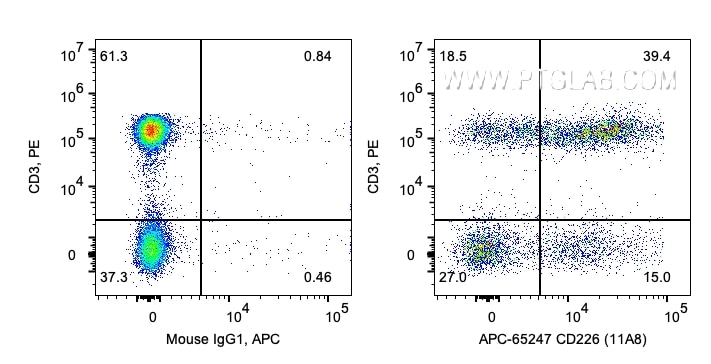Anticorps Monoclonal anti-CD226
CD226 Monoclonal Antibody for FC
Hôte / Isotype
Mouse / IgG1, kappa
Réactivité testée
Humain
Applications
FC
Conjugaison
APC Fluorescent Dye
CloneNo.
11A8
N° de cat : APC-65247
Synonymes
Galerie de données de validation
Applications testées
| Résultats positifs en cytométrie | CMSP humaines, |
Dilution recommandée
| Application | Dilution |
|---|---|
| This reagent has been pre-titrated and tested for flow cytometric analysis. The suggested use of this reagent is 5 µl per 10^6 cells in a 100 µl suspension or 5 µl per 100 µl of whole blood. | |
| Sample-dependent, check data in validation data gallery | |
Informations sur le produit
APC-65247 cible CD226 dans les applications de FC et montre une réactivité avec des échantillons Humain
| Réactivité | Humain |
| Hôte / Isotype | Mouse / IgG1, kappa |
| Clonalité | Monoclonal |
| Type | Anticorps |
| Immunogène | Cellules NK humaines |
| Nom complet | CD226 molecule |
| Masse moléculaire calculée | 336 aa, 39 kDa |
| Numéro d’acquisition GenBank | BC074787 |
| Symbole du gène | CD226 |
| Identification du gène (NCBI) | 10666 |
| Conjugaison | APC Fluorescent Dye |
| Excitation/Emission maxima wavelengths | 650 nm / 660 nm |
| Forme | Liquide |
| Méthode de purification | Purification par affinité |
| Tampon de stockage | PBS with 0.09% sodium azide and 0.5% BSA. |
| Conditions de stockage | Store at 2-8°C. Avoid exposure to light. Stable for one year after shipment. |
Informations générales
CD226 (DNAM-1) is a ~65 kDa glycoprotein expressed on the surface of NK cells, platelets, monocytes and a subset of T cells. It is a member of the Ig-superfamily containing 2 Ig-like domains of the V-set. CD226 mediates cellular adhesion of platelets and megakaryocytic cells to vascular endothelial cells. The protein also plays a role in megakaryocytic cell maturation. Interactions of CD226 and its ligands, CD155 and CD112, induce NK and T cell-mediated cytotoxicity and cytokine secretion (PMID: 15039383).
Protocole
| Product Specific Protocols | |
|---|---|
| FC protocol for APC CD226 antibody APC-65247 | Download protocol |
| Standard Protocols | |
|---|---|
| Click here to view our Standard Protocols |


